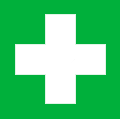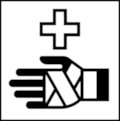Facts and data on pictograms

Synonyms / Other Terms Used
Emergency Care, First Aid Post, First Aid Station
Category
Safety, Health Care, Public Services, Public Facilities
Message / Function
To indicate the location where first and immediate assistance to any person suffering from either a minor or serious illness or injury will be given.
| Source | Description | |
|---|---|---|
 |
ÖNORM A 3011:1980 | Hand with bandage, cross (either outline or in red color) above |
 |
Tern | Hand with bandage, cross (either outline or in red color) above |
 |
UIC | Hand with bandage, green cross above, all outline |
 |
O'72 | Hand with bandaged finger, cross symbol nearby |
 |
BVG | Hand with bandaged finger, cross symbol nearby |
 |
Ecuador | Hand with bandaged finger and three lines indicating pain, cross symbol nearby |
 |
D/FW | Hand with bandaged finger, cross symbol superimposed over hand |
 |
AJATA | Hand with bandaged finger, cross symbol superimposed over hand |
 |
ÖBB 2007 | Hand with bandaged finger, cross symbol superimposed over hand |
 |
Eco-Mo Foundation |
Hand with bandaged finger, cross symbol superimposed over hand |
 |
Erco | Hand with bandaged finger |
 |
O'72 | Top view of stretcher with cross in the middle |
 |
Picto'grafics | Cross in red color on white background |
 |
e.g. AIGA |
Cross symbol in red color on white background |
 |
KSA | Cross symbol in white on red background |
 |
e.g. 92/58/EEC |
Cross symbol in white on green background |
Discussion
The examples shown above are only a small selection from the wide range of pictograms and symbols for First Aid that can be found as public information symbols in guiding systems worldwide. We especially left out quite a few of the manifold variations of crosses and bandaged fingers in use.
In the ISO 1986 Test Series, an international study conducted in Australia, Austria, Hungary, Japan, and the United Kingdom (Brugger 1987), the pictograms of the Austrian Standard ÖNORM A 3011 and of All Japan Airport Terminals Association, Inc. elicited significantly more often responses related to First aid than the white cross on green background. The latter symbol is recommended in the Council Directive 92/58/EEC of the European Communities on the minimum requirements for the provision of safety and/or health signs at work as well as in the international standard ISO 7010 — Graphical symbols -- Safety colours and safety signs -- Registered safety signs. As can be seen from several studies (e.g. Brugger, 1987, Talab & Azari, 2017) this symbol does not work sufficiently across different cultures.
Looking at other studies (Brugger 1978, 1979) the most comprehensible variants were again symbol No 14 of the Austrian standard ÖNORM A 3011, part 2 of the year 1980, and the pictogram of the Munich Olympics 1972. In a later Japanese study to propose domestically unified graphical symbols based on scientific methods, the pictogram variant labeled as Eco-Mo Foundation proved to be well comprehensable with a comprehension score of 89.1, but judged visibility of this pictogram was among the lower values observed (Eco-Mo Foundation, 2001).
The symbol of a red cross is an official protective symbol of the Red Cross. According to the Geneva Conventions and other international laws, the use of this and similar symbols is reserved for official agencies of the International Red Cross and Red Crescent, and as a protective emblem for medical personnel and facilities in combat situations. Use by any other person or organization is illegal, and may lead to prosecution.
From all the tests mentioned above the following conclusions can be drawn:
Besides for legal reasons the use of the red cross alone cannot be recommended, as it is to general. The combined presentation of the cross with an additional symbol narrows the otherwise very general associations down to specific reactions: in case of the bandaged hand or finger the interpretation as 'First Aid'.
Recommendation

Based on the test results known and regarding aspects of visibility/legibility, pictogram No 14 of the Austrian standard ÖNORM A 3011, part 2 of the year 1980 should be used to signify First Aid.
The cross to indicate medical care may be substituted with another symbol appropriate to the culture of the using country.
Tests of pictograms of referent First Aid
Brugger, Ch. (1978): Bericht über die Auswertung des Erkennungstests von November/Dezember 1977. Report to the Austrian Standards Institute (ON) dated 6. 3. 1978, Vienna.
Brugger, Ch. (1979): Abschlußbericht über den Erkennungstest. Report to the Austrian Standards Institute (ON) dated 09/79, Vienna.
Brugger, Ch. (1987): Evaluation of Public Information Symbols, ISO 1986 Test Series: Comprehension/Recognition Test. Vienna: ISO / TC 145 / SC 1.
Brugger, Ch. (1995): ÖBB / ON Testserie 1995, Teil 2 Verständnisschätzungen nach ISO 9186. Report to ÖBB GD 02 (Austrian Railways) dated February 1995, Vienna.
Eco-Mo Foundation (2001): Test data of public information symbols in Japan - Procedure for the testing of public information symbols by the Study Committee. ISO: ISO/TC 145/SC 1 N 329.
Wolf, J.S. & Wogalter, M.S. (1998): Comprehension of Pictorial Symbols: Effects of Context and Test Method. Human Factors (40), 173-186.
See also
Updated 2023-07-26 by Ch.Brugger